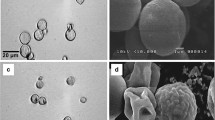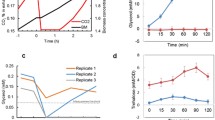Abstract
The osmotolerant fungusAspergillus chevalieri tolerates up to 80% sucrose concentration in the growth medium. At 50% sucrose the growth rate is 1.5-fold higher than in control (3% sucrose), at 80% sucrose it drops to 30% of the control level. Total proteins and lipids in the mitochondrial fractions obtained from the mycelium rise with increasing sucrose concentration during growth (2.6 and 2.1 times at 80% sucrose). The rate of respiration by whole cells and mitochondrial fractions increases with increased sucrose level in the growth medium. The activity of respiratory enzymes, such as succinate dehydrogenase, cytochrome oxidase, NADH oxidase and succinate oxidase, were also higher in cells growth in the presence of elevated sucrose concentrations. The largest increase was observed with NADH dehydrogenase.A. chevalieri cells grown at high osmotic stress exhibited enlarged mitochondria. The mean mitochondrial diameter at 50 and 80% sucrose was approximately 2.9- and 2.6-fold larger than in the control, respectively. Agarose gel electrophoresis of nucleic acids revealed the presence of high-density bands of RNA in mitochondrial fractions from cells grown at elevated sucrose levels.
Similar content being viewed by others
References
Agrawal S.C., Singh V.: Viability of dried vegetative cells and the formation and germination of reproductive structures inPithophora œdogonia, Cladophora glomerata andRhizoclonium hieroglyphicum under water stress.Folia Microbiol. 44, 63–70 (1999a).
Agrawal S.C., Singh V.: Viability of dried vegetative trichomes, formation of akinetes and heterocysts and akinete germination in some blue-green algae under water stress.Folia Microbiol. 44, 411–416 (1999b).
Barnes H., Blackstock J.: Estimation of lipids in marine animals and tissue: detailed investigation of total lipids.J. Exp. Mar. Ecol. 12, 101–118 (1973).
Brown A.D.: Microbial water stress.Bacter. Rev. 40, 803–846 (1976).
Brown A.D.: Compatible solutes and extreme water stress in eukaryotic microorganisms.Adv. Microbiol. Physiol. 17, 181–242 (1978).
Davidson D.E.: The effect of salinity on a marine and a fresh waterAscomycetes.Can. J. Bot. 52, 553–563 (1974).
De Robertis E.D.P., Nowinski W.W., Saez F.A.:Cell Biology. Saunders Co., Philadelphia-London-Toronto 1970.
Elnaby S.E.H.: Rapid and simple technique of total genomic damage (TGD) of DNA in human lymphocytes and its application on some mutagenic agents.J. Union Arab. Biol. 14A,Zoology 371–388 (2000).
Emerson D.N.: Influence of salinity on ammonia excretion rates and tissue constituents of euryhaline invertebrates.Comp. Biochem. Physiol. 29A, 1115–1133 (1969).
Hefnawy M.A.: Influence of certain stress conditions in the metabolic disorder of some fungi.PhD Thesis. Menoufia University, Shebin El-Kom (Egypt) 1993.
Hefnawy M.A.: Polyols and soluble amino acids in two filamentous fungi grown under reduced water activity, pp. 135–141 inProc. 2nd Internat. Conference on Fungi: Hopes and Challenges, Vol. II. Cairo 1999.
Hefnawy M.A., El-Halafawy K., El-Mongi M.: Changes in phospholipids and fatty acid composition ofPenicillium corylophilum andHalobacterium halobium as a response of NaCl stress.African J. Mycol. Biotechnol. 5 (3), 37–48 (1997).
Hefnawy M.A., Evans R.L.: Effect of osmotic stress on the respiratory activity ofPenicillium expansum.Microbiol. Res. 153, 131–135 (1998).
Hefnawy M.A., Nasr M.I., El-Mongy M.: Growth and soluble amino acid composition inPencillium corylophilum andHalobacterium halobium grown under salt stress.Folia Microbiol. 44, 25–31 (1999).
Herrera F.C., Lopez I.: Relationship between external sodium concentration and intracellular osmotic effects in respiratory tree ofHolothuria glaberrima.Comp. Biochem. Physiol. 74A, 267–274 (1983).
Jennings D.H.: Some aspects of physiology and biochemistry of marine fungi.Biol. Rev. 58, 423–459 (1983).
Khanna G., Lynne D., Brown L., Niven S.D.F., Macleod R.A.: Relation between ion requirements for respiration and membrane transport in a marine bacterium.J. Bacteriol. 157, 59–63 (1984).
King T.E., Howard R.L.: Oxidation and phosphorylation.Methods Enzymol. 10, 275–294 (1967).
Livne A., Levin N.: Tissue respiration and mitochondrial oxidative phosphorylation of NaCl-treated pea seedlings.Plant Physiol. 42, 407–414 (1967).
Mogi K., Uchida K., Mogi K.: Cellular fatty acids of soy yeasts and osmophilic yeasts.Nippon Nogeikagakun Kaishi 46, 657–663 (1972).
Munda I.: The effect of salinity on the respiration and photosynthesis of the brown algaAscophyllum nodosum.Biol. Vestig. 11, 3–13 (1964).
Parekh T.V., Chhatpar H.S.: Effect of salt stress on the respiratory activity ofAspergillus sydowii.Curr. Microbiol. 19, 297–301 (1989).
Sarin M.N.: Physiological studies on salt tolerance in crop plants. XIV. Further studies on the effect of sodium sulfate on respiration on wheat and gram seedlings.Indian J. Plant. Physiol. 4, 38–46 (1961).
Tunblad-Johansson I., Adler L.: Effect of sodium chloride concentration on phospholipids. Fatty acid composition of yeasts differing in osmotolerance.FEMS Microbiol. Lett. 43, 275–278 (1987).
Vreeland R.H.: Mechanisms of halotolerance in microorganisms.CRC Crit. Rev. Microbiol. 14, 311–356 (1987).
Watanabe Y., Takakuwa M.: Changes of lipid composition ofZygosaccharomyces rouxii after transfer to high sodium chloride culture medium.J. Ferment. Technol. 65, 365–369 (1987).
Yancey P.H., Clark M.E., Hand S.C., Bowlus R.D., Somero G.N.: Living with water stress: evolution of osmolyte systems.Science 217, 1214–1222 (1982).
Author information
Authors and Affiliations
Rights and permissions
About this article
Cite this article
Hefnawy, M.A. Effect of osmotic stress onAspergillus chevalieri respiratory system. Folia Microbiol 46, 407–412 (2001). https://doi.org/10.1007/BF02814430
Received:
Issue Date:
DOI: https://doi.org/10.1007/BF02814430




